skip to main |
skip to sidebar
I think I may have found the most PERFECT masala recipe I've ever tried, and all thanks to Sangeeta of Banaras ka Khana blog. Her blog is one of my favourites, because she has North Indian recipes which are not so well known (at least to me) as the usual things you get endlessly everywhere. I like reading about typical everyday recipes which are still not common outside of individual homes, and Sangeeta's blog is the perfect place to find these.
I tried this masala with cooked chickpeas because I had some, and loved the result so much that I've made it (with different dals) four times in the last 10 days... although not (yet) with the original split chickpeas (or chana dal) that Sangeetha used. I've tried it both as a thick sauce and as a runnier one, and it makes not a whit of difference - other than the clingy sauce is better with whole chickpeas.
I reduced the peppercorns to 1/2 tsp because I can't take the heat from them (but chilli-heat is more than bearable, go figure), but otherwise the recipe is no different - well, apart from having used chickpeas, that is. Do try it - it's pretty quick to make, too, especially if you use canned chickpeas.
Recipe for: Chana bhuna
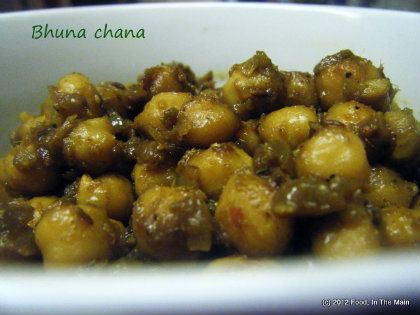
Ingredients:3-4 cups cooked chickpeas (or two cans' worth)
1 large onion, chopped fine
1 tbsp ghee or oil (I used oil)
1 tsp cumin seeds
Salt to taste
For grinding:

1/2" piece cinnamon stick
1 small black cardamom (seeds only)
1 htsp coriander seeds
1 htsp cumin seeds
2 cloves
4-5 dried red chillies (or to taste)
3 garlic cloves
1" ginger root
1/2 tsp black peppercorns
1/2 tsp turmeric powder
1/2 tsp amchoor (dried raw mango) powder - optional
3-4 tbsp water
Method:1. Grind all the ingredients for the masala into a smooth, fairly thick paste. Use only as much water as required to make it smooth.
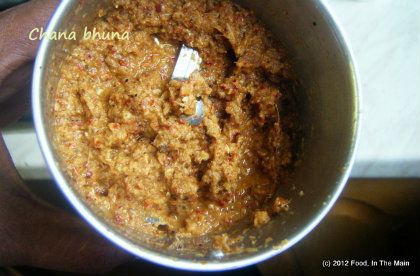
2. Heat the oil/ghee in a pan, then add the cumin seeds.
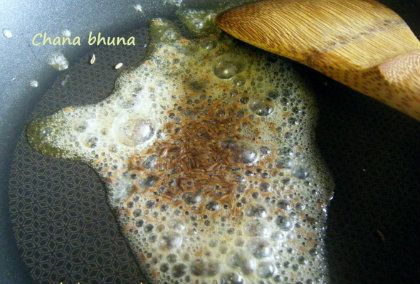
3. Once the seeds sizzle, add the chopped onion and stir.
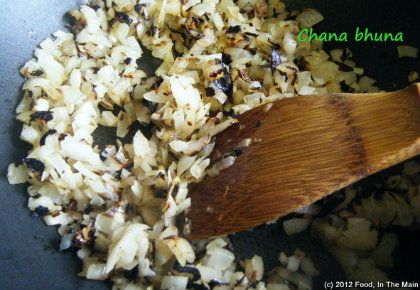
Let it cook on low heat for 15 minutes or so, till it becomes soft and pinkish.
4. Now add the ground masala paste to the cooked onion
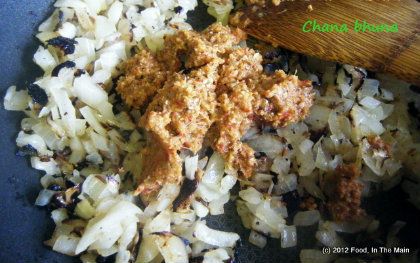
and stir it in.

5. Fry it (bhuno) on low heat for 5-7 minutes, stirring frequently, till the paste is well amalgamated, thick and intensely aromatic. Any excess water should have evaporated.
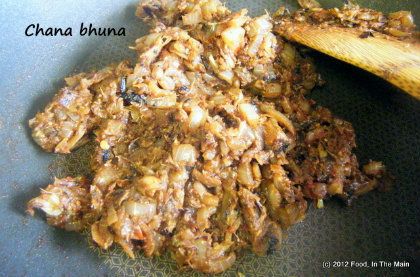
6. Now add the chickpeas along with salt to taste

and stir till it is all well mixed.
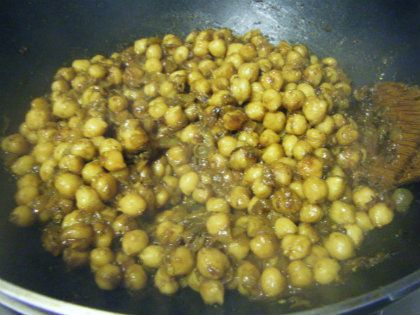
7. Let it cook for 2-3 minutes more (longer if it is watery), then take it off the heat.
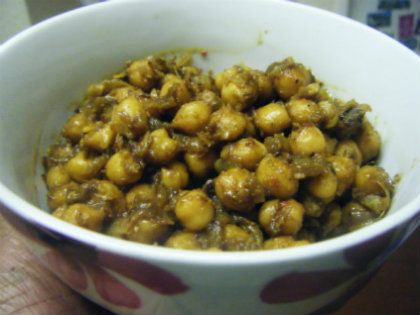
Serve hot with chapaties or puris.
Note: The curry tastes best when the masala coats the chickpeas thickly, so make sure the masala is not runny.
RECIPE: CHANA BHUNA
Ingredients:
3-4 cups cooked chickpeas (or two cans' worth)
1 large onion, chopped fine
1 tbsp ghee or oil
1 tsp cumin seeds
Salt to taste
For grinding:
1/2" piece cinnamon stick
1 small black cardamom (seeds only)
1 htsp coriander seeds
1 htsp cumin seeds
2 cloves
4-5 dried red chillies (or to taste)
3 garlic cloves
1" ginger root
1/2 tsp black peppercorns
1/2 tsp turmeric powder
1/2 tsp amchoor (dried raw mango) powder - optional
3-4 tbsp water
Method:
1. Grind all the ingredients for the masala into a smooth, fairly thick paste. Use only as much water as required to make it smooth.
2. Heat the oil in a pan, then add the cumin seeds.
3. Once the seeds sizzle, add the chopped onion and stir. Let it cook on low heat for 15 minutes or so, till it becomes soft and pinkish.
4. Now add the ground masala paste to the cooked onion and stir it in.
5. Fry it (bhuno) on low heat for 5-7 minutes, stirring frequently, till the paste is well amalgamated, thick and intensely aromatic. Any excess water should have evaporated.
6. Now add the chickpeas along with salt to taste and stir till it is all well mixed.
7. Let it cook for 2-3 minutes more, then take it off the heat. Serve hot with chapaties or puris.
Note: The curry tastes best when the masala coats the chickpeas thickly, so make sure the masala is not runny.
Sometimes what you think is a brilliantly innovative idea turns out to be somewhat less than that. Even if not a total flop, the idea certainly isn’t close to what was visualised. For instance - I recently bought a pack of Lapsang Souchong tea (no, that was not the innovative part, that was just what I thought was the brilliant part. Wait for it, people, wait for it. The point will make its grand debut further down this post. Watch for the trumpet fanfare that will announce its arrival.)
Over the years I’d heard a lot about Lapsang Souchong. It was the name that attracted me first, to tell the truth. Lapsang Souchong. Such a treat for the vocal cords. Lapsang Souchong. Lapsang Souchong. Lapsang Souchong. (It made me feel sophisticated just saying the name.) So anyway, I’d read about how this tea embodied the essence of refinement, how delicately smoky it tasted, how it was loved by the top connoisseurs of tea in general, and so on. In the past I was not drawn to the idea of tea at all, even with milk and sugar – and the idea of drinking tea that had neither milk nor sugar seemed incomprehensible. Not even a genuine tea-connoisseur favourite uncle could tempt me to try drinking tea black.
But of late, since I have been drinking fruit teas and green tea, I thought that my palate ok, that *I* was finally sophisticated enough for this supposed queen of teas. It seemed promising enough when I bought the box because I could smell the smokiness even without opening it.
As I poured hot – not boiling, as specified by the instructions – water on the teabag in my mug, my senses were assailed by the lovely smoky aroma. Alas, the tea itself was rather too bitter for me. Evidently my palate (please note this – my palate, not me) had not reached the level of sophistication required to drink Lapsang Souchong. (Perhaps I should have used a fine bone china cup from which to drink the tea, rather than a Tesco mug that had “Tea Coffee Tea Coffee” printed all over it in striking black and white stripes? Ah well, we will not make this discovery in a hurry, and enquiring readers will just have to wait till I can muster the willpower – and the requisite refinement of the five senses - to try Lapsang Souchong again. From a posh china cup.)
So anyway, the remaining 39 tea bags sat in their box in a drawer, perfuming the air delicately with their smokiness whenever the drawer was opened, for a couple of weeks before I had my next *trumpet fanfare* idea. (Yes, folks, this was Part 2 - the innovative part – of the original brilliant idea.)
I have liked the flavour of smoked food, ever since, years and years back in a Maori village in New Zealand, I tried it for the first time at the traditional “hangi” or feast. (That’s another story, which you can find here.) So I was suddenly struck by the thought that I could use a Lapsang Souchong tea-bag while cooking some soya beans (the dried kind, after first soaking the beans overnight). Two birds with one stone, and all that... I could use up the tea bags eventually, and hopefully the lovely smoked flavour would infuse into the soya beans.
Uh...
That innovative idea? Innovative, perhaps, but sadly not brilliant in its outcome. The smoky taste did NOT get into the beans or the cooking liquid, but the tea did turn the beans a beautiful (NOT!) brownish grey. Overall, I would say that pressure-cooking the beans with a Lapsang Souchong teabag did not add anything in the way of extra flavour, but also, let it be said, it did not detract from the taste of the beans. I was going to make a superbly and subtly smoky soya bean chole sort of thing, but in the event, I decided to do something else with the tea-cooked beans.
And that is how this sesame soyabean pulao happened. Looks quite nice, doesn't it? It tasted as good as it looks - and I personally believe it looks verrrrry good!
Mind it!
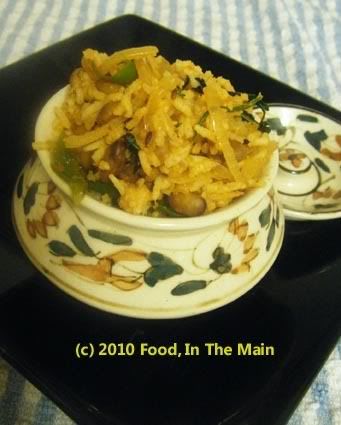
Recipe for: Sesame soyabean pulao
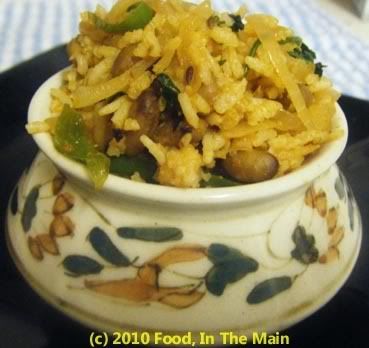
Ingredients:
4-5 cups cooked basmati rice, cooled
1-1/2 cups cooked soyabeans
2 medium onions, sliced thin
4-5 green chillies, sliced into strips (to taste)
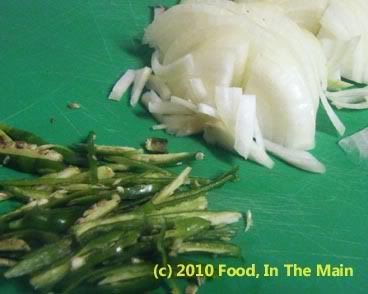
3 tbsp sesame seeds, crushed lightly in a mortar & pestle
1/4 cup concentrated tomato puree
1" stick cinnamon
1 star anise
1 green cardamom
1 black cardamom (optional)
2 tsp cumin seeds
1 tbsp oil
Salt to taste
2 tbsp chopped coriander for garnish
Method:
1. Heat the oil in a pan big enough to comfortably take 4 cups cooked rice. When the oil is hot, add the cumin seeds, cinnamon stick, cardamoms and star anise. Let them brown gently (about a minute) till their aroma is released.
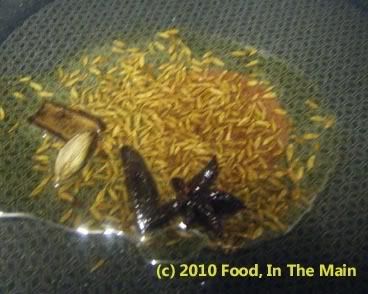
2. Now add the sesame seeds and let them fry till they begin to turn a pale brown.
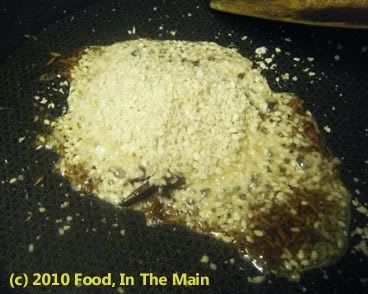
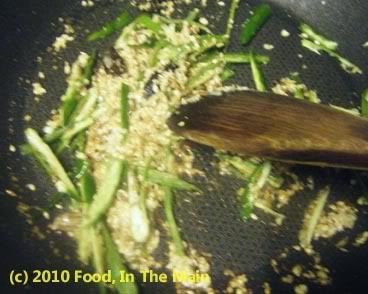
3. Add the onions and stir fry on medium heat till the onions begin to turn soft.
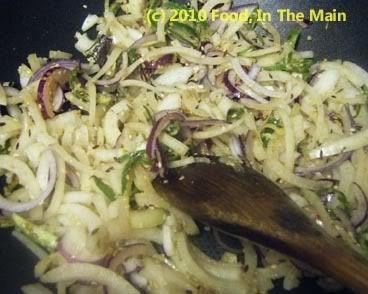
4. Pour in the tomato puree.
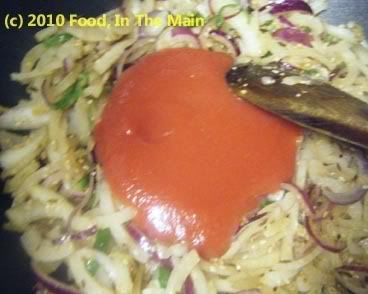
5. Mix it in well,
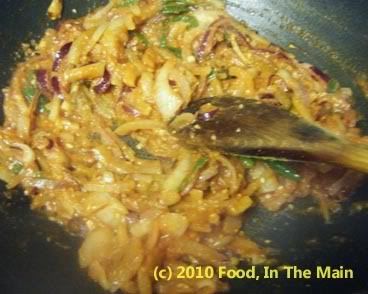
then add the cooked soyabeans.
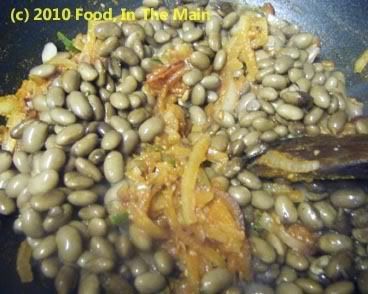
Stir them in gently till they are completely covered with the onion masala. The masala should not be runny or watery, or the pulao will not taste right.
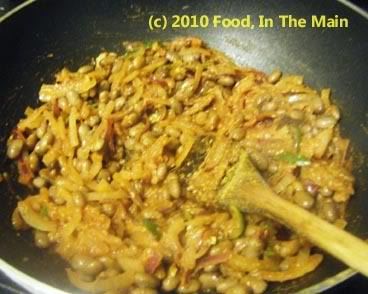
6. Add the chopped coriander and stir it in, along with salt to taste.
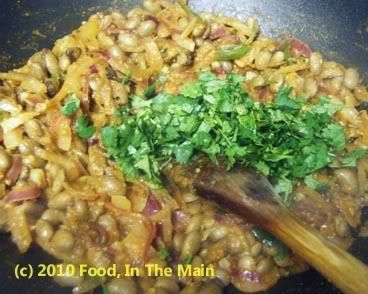
7. Now mix the cooked rice with the soyabean masala, taking care not to break up the grains.
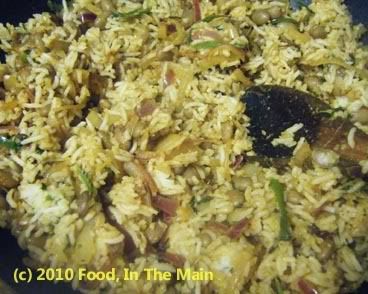
8. Serve hot with any raita.
 Kala chana is both the name of this variety of chickpeas and of the dish made with them - an economy of words indeed. Although kala chana or black chickpeas (actually they're brown in colour!) are a variety of chickpeas, they look and taste very different from the more common white kind (kabuli chana) that are used to make, among other things, hummous and chole. I personally like them better, because they have a stronger, earthier flavour that is not masked by the masala that is used to make the curry.
Kala chana is both the name of this variety of chickpeas and of the dish made with them - an economy of words indeed. Although kala chana or black chickpeas (actually they're brown in colour!) are a variety of chickpeas, they look and taste very different from the more common white kind (kabuli chana) that are used to make, among other things, hummous and chole. I personally like them better, because they have a stronger, earthier flavour that is not masked by the masala that is used to make the curry.
These chana can be soaked overnight in water, but 3-4 hours is usually enough to make them grow plump in the water and ready for cooking.

I also like kala chana plain boiled, sauteed in a little oil and tempered with the usual mix of mustard seeds, some dried red chillies, asafoetida powder and urad dal - they make for a tasty, healthy snack with just this tempering, or with the addition of freshly grated coconut for garnish. This dish (called sundal) is usually made as prasadam or holy offering during certain festivals, but I like to make them even otherwise.
Not this time, though... this time it was kala chana curry for my vegetarian sister-in-law, who regularly invites herself over for a home-cooked Indian meal!
Recipe for: Kala chana
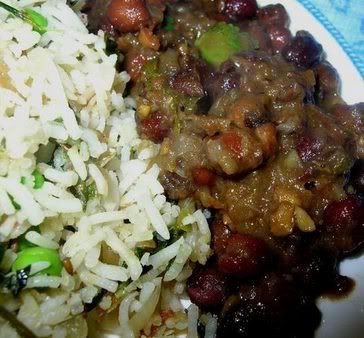
Ingredients:
4 tomatoes, de-skinned and chopped finely (To de-skin the tomatoes, make a small shallow cut in the skin, then put the tomatoes in a bowl and cover with boiling water. Let rest for 3-4 minutes. Pour out the water and slip off the tomato skins - they will come off easily)

1 cup kala chana, soaked in plenty of water overnight
2 medium onions, chopped fine
1 tsp ginger, grated
4-5 green chillies (or to taste), minced or sliced into fine rounds
2 bay leaves
1" cinnamon stick
2 black cardamom pods, left whole
1 tsp cumin seeds
1 htsp chana or chole masala
or
1/2 tsp garam masala
Salt to taste
2 tsp oil
Fresh coriander, chopped, for garnish
Thinly sliced tomatoes and onion rings for garnish (optional)
Method:
1. Pressure-cook the soaked kala chana with the bay leaves, whole black cardamom pods and cinnamon stick in enough water to cover the chana fully. Do not overcook. (They should hold their shape yet be easy to mash when a little pressure is applied.) Remove the bay leaves, the whole cardamom and cinnamon stick and discard.
2. In a wide pan, heat the oil. Add the grated ginger, the chopped green chillies, the cumin seeds. Fry for 1 minute, then add the chopped onions. Fry till the onions become soft and are beginning to turn slightly brown.

3. Add the chopped tomatoes and the garam masala/chana or chole masala and stir. Add 1/2 cup water and cook till the tomatoes break down and become mushy.
4. Now add the cooked kala chana (reserving 1/4 cup) and salt to taste. Stir well to coat.
5. Add some more water if required, to make a thick gravy, and let the kala chana simmer away for 5 minutes.
6. Mash the reserved 1/4 cup of the chana and add it to the pan. Stir again. This will thicken the chana.
7. Garnish with the tomato slices and onion rings (if using), and scatter the coriander leaves on top.
8. Serve hot with rice, chapatis or puris.
This masala powder is very aromatic and keeps for a few months if stored in an airtight jar. The measures I'm giving here makes enough powder to use twice, but the amounts can easily be increased proportionally to make more.
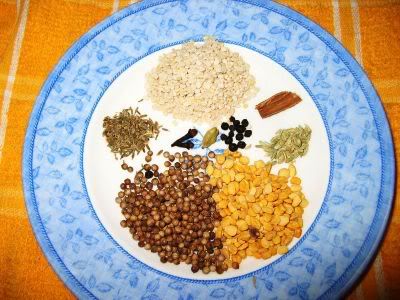
Clockwise from the top: Urad dal, cinnamon stick, fennel seeds, chana dal, coriander seeds, cumin seeds. Centre (from left): Cloves, cardamom pod, black peppercorns
Recipe for: Masala powder for carrot rice
Ingredients:
2 tsp urad dal
2 tsp chana dal
2 tsp coriander seeds
1/2 tsp cumin seeds
1/2 tsp black peppercorns
1/2 tsp fennel seeds
1/2 inch stick cinnamon
2 cloves
1 cardamom pod
2 dried red chillies
5-6 curry leaves
1 tsp oil
Method:
1. Heat the oil in a pan and add all the items. Fry on medium heat, stirring frequently, until the dals turn golden and aromatic.

2. Let cool completely, then grind to a fine powder in a spice or coffee grinder. Store in an airtight jar for upto 6 months.
































